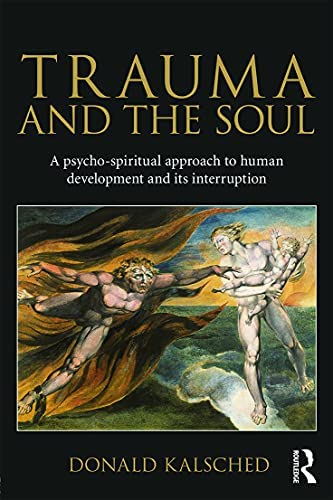Trauma and the soul: A psychospiritual approach to human development and its interruption
Donald Kalsched
Introduction
Ch. 1: Trauma and life-saving encounters with the numinous
Ch. 2: Loss and recovery of the soul child
Ch. 3: Dissociation and the Dark Side of the Defensive System
Ch. 4: Trauma, Transformation, and Transcendence
Ch. 5: Wholeness and anti-wholeness defenses
Ch. 6: Psychoanalytic approaches to the inner world
Ch. 7: Innocence, its loss, and recovery
Ch. 8: Jung’s Divided Self
Introduction
Often the transpersonal, sacred story holds the survivor’s pain before a human story can be told. (5)
It has been said that there are no atheists in foxholes. There are also few, if any, atheists among trauma survivors (5)
Jungian analysis has been especially guilty of this ascent into metallization and the pursuit of intellectual meaning. (8)
Dissociation seals over non-being. It prevents annihilation of the unit self, substituting multiplicity and an archetypal story that implicitly holds the parts together. The unbearable affect is distributed to different parts of the psyche/soma. These parts cease to know about each other so that the personality does not have to suffer the unspeakable horror of trauma as a whole... These self-divisions have survival value because they save a part of the child’s innocence and aliveness by splitting it off from the rest of the personality, preserving it in the unconscious for possible future growth and surrounding it with an implicit narrative that is eventually made explicit in dreams. This allows life to go on, albeit at a terrible price–i.e., loss of the animation and vitality that have always been associated with ensouled living. So, ironically, dissociative defenses save a vital core of the self while simultaneously losing it (or losing it partially). They preserve the seed by cutting it off from life in this world… at least for a time. (11)
Usually the regressed part of the personality is represented as a child or infant, often locked away (12)
James Grotstein (2000: 165) refers to a “hostage self” that frequently appears in abused or traumatized patients as an “undead child” haunting them from within. (14)
A whole person is a psycho-somatic unity who embodies a vital spark at the center of its integrated body/mind being. (18)
The indwelling soul confers a feeling of being real–a sense that we have a God-given right to be here. At its best, then, psychotherapy is partly a spiritual discipline helping both parties participate in this world as a potential space in which both material and spiritual energies support each other toward the goal of what Jung called individuation–realizing your destiny, becoming who you really are, becoming an ensouled person. (19)
Trauma constitutes an interruption of the normal processes through which an embodied, true self comes into being. (19)
James Grotstein (2000: 49) suggests that trauma is about encountering the world before the baby has had a chance to create it. (19)
Ch. 1: Trauma and life-saving encounters with the numinous
The broken places or lines of cleavage represent what we call moments of dissociation, and dissociation is something the psyche does in response to trauma. (23)
These powers normally support the ego’s functioning, but at critical moments (trauma) they are recruited for defensive purposes, and without help this leads to psychopathology and unlived life. (24)
individuals with a history of childhood trauma frequently seem to have access to altered states in which they are tuned in, as it were, to frequencies that most of us cannot see or hear. (24)
This is the matrix from which all meaningful stories grow, and the soul needs a story–a resonant image–that is adequate to its own biography. (31)
Ch. 2: Loss and recovery of the soul child
The seashore, like transitional space, defines an area between the water and the land that unites two opposite realities in a third area that participates in both, yet transcends them. (56)
It is this correspondence between child and soul that seems to account for the fact that, in dreams, the child can be said to symbolize the soul or to represent a symbolic carrier of that spiritual substance we refer to as the soul. (56)
If trauma is to be healed, the potential aliveness locked up with this inner child will have to be touched and quickened by the therapy process. (60)
Amplification was a technique Jung used when he encountered collective material in dreams. It is rather like gathering the free associations of the entire cultural canon to a particular image–mythology, religious iconography, folk lore, literature, etc. (65)
Anti-individuation factor (83)
Ch. 3: Dissociation and the Dark Side of the Defensive System
As we have seen, trauma interrupts indwelling and the normal descent of the radiant light-bearing soul into the body is compromised. A split opens up between “bad” (shame-ridden) affects in the body and “good,” perfectionistic thoughts in the mind. (89)
Dis emerges to make sure this unbearable affect is not experienced. He refuses embodiment. (89)
Traumatic experience in early childhood is managed by dissociation, which chops up the components of experience and makes life possible–in compartments. (93)
Charming, attractive, and ingratiating on the outside, she began to hate her inner feminine child-self because of its neediness and its dependency, and she began to hate the imperfect, inferior “fat” body where it lived. (111)
Such a body-sensitive approach proceeds from the understanding that past trauma and its defenses will be encoded in present physiological states such as breath, gestures, muscular tension, averted gaze, etc. and not in higher cortical regions where they could be recovered as explicit memories (115)
Ch. 4: Trauma, Transformation, and Transcendence
Trauma is by definition unbeatable pain–in other words, affect that cannot be metabolized by the psyche’s normal symbolic processes. (132) #glossary
The “music” of the session sometimes was as important as the content, he reported. (134)
Ch. 5: Wholeness and Anti-Wholeness Defenses
Dreams are especially important in the psychotherapy process because often they offer a non-distorting mirror that reflects our larger potential selfhood. (160)
Shame seems to be our feeling-response when who we are is found unacceptable, not merely what we’ve done. (163) #glossary
The unfolding of this potential wholeness from within is what Jung meant by individuation–“the strongest, the most ineluctable urge in every being, namely the urge to realize itself” (Jung, 1949, para. 289). #glossary
The right hemisphere has a closer affinity with the emotions and bodily experience and what has been called body-image or “self-concept.” (173)
Its affinity with emotional life explains why the right hemisphere also mediates our experience of music. (173)
in general, the right hemisphere seems to be more in tune with sadness and less with anger. (176)
In other words, injury to the right hemisphere leads to primitive defenses that in turn lead to a “hardening of the heart” and, though such hardening, to a variety of psychopathologies involving rigidified self-schemas and inner fragmentation. (176)
Without the “glue” provided by the integrative functions of the right hemisphere, a coherent sense of oneself dissolves. (178)
As McGilchrist noted, the left hemisphere is the hemisphere of denial. (178)
In any case, the mechanism of dissociation is likely to make use of the brain’s bilateral division. (178)
She was somehow stained now, contaminated–full of an anguished longing. It was the end of her childhood. (181)
The dream suggests that her healthy sexual response returns with the re-connection to this Father, made possible by the mediating figure–the man in the dream with whom all the Eros is flowing. (184)
Ch. 6: Psychoanalytic approaches to the inner world
The child represents both this world and another ineffable world simultaneously. The child animates our experience with something more than just our memories. It finds its true life “between the worlds.” (190)
Private space opens when one is disengaged, but it is more than simple non-relatedness. It represents a true alternative environment–another world–and its recognition in analysis by the analyst can have a healing effect. (196)
Conscience never condemns, as in a guilty conscience, but rather “invites.” (199)
Dreams help us to differentiate and process the components of our experience, rendering them into symbolic meaning. (207)
Ch. 7: Innocence, its loss, and recovery
This grief seems to happen only when the two worlds meet and are held in tension, consciously. (225)
Such hope-filled “love,” with its re-activation of lose innocense and its prospect of a union ”between the worlds”… has been discussed under the general topic of idealization. (228)

